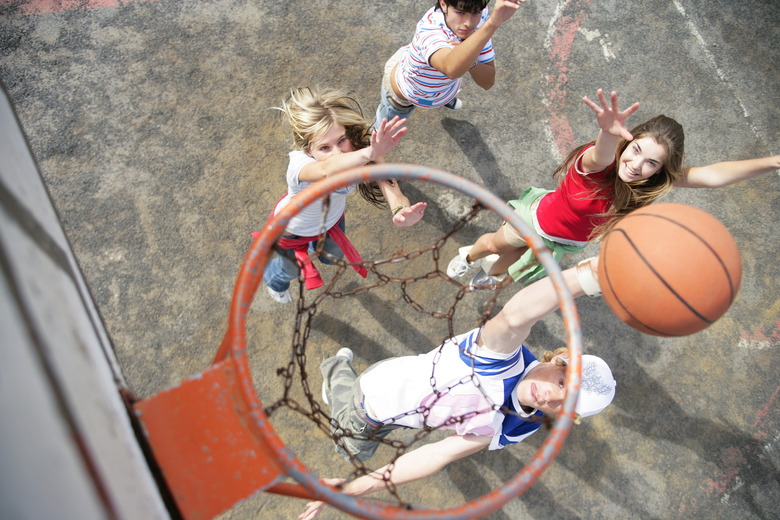How Do The Laws Of Motion Apply To Basketball?
Law of Inertia
Law of Inertia
Isaac Newton's first law of motion states that an object at rest tends to stay at rest, while an object in motion tends to stay in motion unless an external force acts upon it. When a basketball player shoots, it would appear that there is nothing to obstruct the ball. However, several external forces act upon the ball. Were it not for these forces, the ball would continue to travel in its current direction. First, gravity acts upon the ball to pull it down to earth. The athlete must judge the force of gravity by the weight of the ball to be able to find the right line of trajectory so the ball arcs into the basket. Air also resists the ball in the form of drag. While not noticeable indoors, wind can be a major factor during outdoor games.
F=MA
F=MA
Newton's second law states that acceleration is produced when a force acts on a mass. The greater the mass of the object being accelerated, the more force needed to accelerate that object. The equation is expressed as Force = mass x acceleration. In basketball, we see Newton's third law at work whenever a player shoots or passes the ball. The basketball has mass, which means that the player must use the appropriate amount of force when shooting or passing. Too much or too little force applied in relation to the ball's mass and the ball will not go where intended. If a basketball were to be substituted with a bowling ball, for instance, the players would need to use much more force to move the ball the same distance.
Action/Reaction
Action/Reaction
The third law of motion is that for every force, there is an equal reaction force in the opposite direction. Action/reaction is what allows the athletes to make their way up and down the court. When the player takes a stride, they put force into the floor. Because the floor has too much mass for the athlete to move it, the force travels back to the athlete and propels him forward. Because the floor will apply an equal and opposite reaction, whichever direction the athlete applies force will be opposite to the direction force is applied back. If the athlete's foot pushes the floor behind them, the force from the floor (called "ground reaction") will propel the forward. If the athlete quickly applies force straight down, the ground reaction will propel them straight up and allow the athlete to jump.
References
Cite This Article
MLA
Benjamin, David. "How Do The Laws Of Motion Apply To Basketball?" sciencing.com, https://www.sciencing.com/how-do-the-laws-of-motion-apply-to-basketball-4218420/. 5 December 2018.
APA
Benjamin, David. (2018, December 5). How Do The Laws Of Motion Apply To Basketball?. sciencing.com. Retrieved from https://www.sciencing.com/how-do-the-laws-of-motion-apply-to-basketball-4218420/
Chicago
Benjamin, David. How Do The Laws Of Motion Apply To Basketball? last modified March 24, 2022. https://www.sciencing.com/how-do-the-laws-of-motion-apply-to-basketball-4218420/
